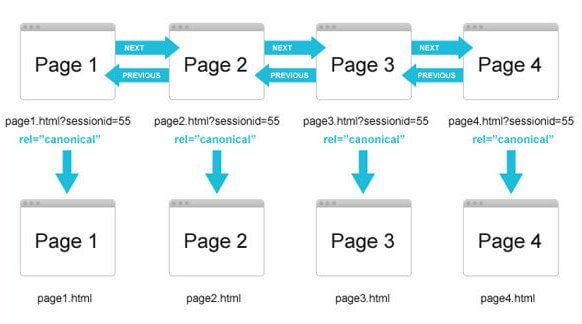
Here are tips from official Google Guidelines that help to implement “Pagination” attributes to solve duplicate content for websites especially news website
Implementing rel=”next” and rel=”prev”
If you prefer option 3 (above) for your site, let’s get started! Let’s say you have content paginated into the URLs:
http://www.example.com/article?story=abc&page=1
http://www.example.com/article?story=abc&page=2
http://www.example.com/article?story=abc&page=3
http://www.example.com/article?story=abc&page=4
On the first page, http://www.example.com/article?story=abc&page=1, you’d include in the<head> section:
<link rel="next" href="http://www.example.com/article?story=abc&page=2" />
On the second page, http://www.example.com/article?story=abc&page=2:
<link rel="prev" href="http://www.example.com/article?story=abc&page=1" />
<link rel="next" href="http://www.example.com/article?story=abc&page=3" />
On the third page, http://www.example.com/article?story=abc&page=3:
<link rel="prev" href="http://www.example.com/article?story=abc&page=2" />
<link rel="next" href="http://www.example.com/article?story=abc&page=4" />
And on the last page, http://www.example.com/article?story=abc&page=4:
<link rel="prev" href="http://www.example.com/article?story=abc&page=3" />
A few points to mention:
- The first page only contains rel=”next” and no rel=”prev” markup.
- Pages two to the second-to-last page should be doubly-linked with both rel=”next” and rel=”prev” markup.
- The last page only contains markup for rel=”prev”, not rel=”next”.
- rel=”next” and rel=”prev” values can be either relative or absolute URLs (as allowed by the
<link>tag). And, if you include a<base>link in your document, relative paths will resolve according to the base URL.
- rel=”next” and rel=”prev” only need to be declared within the
<head>section, not within the document<body>.
- We allow rel=”previous” as a syntactic variant of rel=”prev” links.
- rel=”next” and rel=”previous” on the one hand and rel=”canonical” on the other constitute independent concepts. Both declarations can be included in the same page. For example, http://www.example.com/article?story=abc&page=2&sessionid=123 may contain:
<link rel="canonical" href="http://www.example.com/article?story=abc&page=2”/>
<link rel="prev" href="http://www.example.com/article?story=abc&page=1&sessionid=123" />
<link rel="next" href="http://www.example.com/article?story=abc&page=3&sessionid=123" />
- rel=”prev” and rel=”next” act as hints to Google, not absolute directives.
- When implemented incorrectly, such as omitting an expected rel=”prev” or rel=”next” designation in the series, we’ll continue to index the page(s), and rely on our own heuristics to understand your content.
You May
Also Like .
YOU MAY ALSO LIKE.

October 17, 2024 – News
Chain Reaction x Funnel : A powerful partnership for infinite possibilities.



